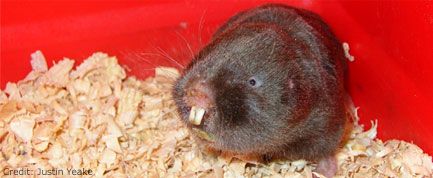
Early humans might have turned to plant roots and underground storage organs when fruit was scarce, a new study suggests.
A 1999 analysis of teeth belonging to two species of hominids, Australopithecus aferensis and Paranthropus robustus, living 2 million years ago found chemical evidence that one-third of their diet consisted of grasses and sedges, or the meat of animals that ate such plants.
The finding puzzled some scientists because the hominids had flat, thickly enameled molars best suited for chewing hard, brittle foods, not tough items like grass or meat. This discrepancy became known as the “C4 connundrum,” named after the type of photosynthesis grasses and sedges use to create the unique chemical signature.
New view
Now researchers led by Nathanial Dominy of the University of California, Santa Cruz say they have possibly solved the C4 connundrum by showing early humans dined not on the leafy parts of grasses and sedges, but their underground storage organs, or USOs, such as corms, bulbs, and rhizomes.
USOs are more brittle and thus better suited for the robust anatomical features of early humans, and they also produce the same chemical signatures as the above-ground parts of grasses and sedges, the scientists say.
Dominy and his team reached their conclusions after positively matching chemical signatures in the bones of mole rats—small, tunneling creatures that also eats USOs—living today across Africa with signatures from mole rats living at the same time and in the same region as the early hominids. Furthermore, the mole rat signatures overlapped with those from the early hominin teeth.
Sign up for the Live Science daily newsletter now
Get the world’s most fascinating discoveries delivered straight to your inbox.
“This shows that without doubt there were underground storage organs with the C4 signature at the same time and at the same place that these [hominids] lived,” Dominy told LiveScience. “So they could’ve eaten them.”
The findings are detailed in the current online issue of the Proceedings of the Royal Society B: Biological Sciences.
Skepticism
Mark Teaford, an anthropologist at John Hopkins University who was not involved in the study, says the findings provide scientists with another clue about the diet of early hominids. “It doesn’t mean our ancestors specialized on USOs. It simply doesn’t rule out the possibility of them eating USOs,” Teaford said.
Stanley Ambrose, an anthropologist at University of Illinois, is more skeptical. The main C4 food that mole rats eat is grass corms, which are “tiny and would not provide enough food for large-bodied hominids,” Ambrose said in an email interview.
Also, “in the dry savanna environment surrounding the early hominid sites analyzed, there is little evidence for swampy habitats where really abundant C4 plant foods would have been available,” Ambrose said.












